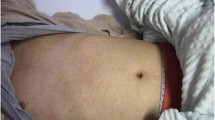Abstract
Measles is an acute, highly contagious, airborne disease caused by Paramyxoviridae ribonucleic acid (RNA) virus. While rare in the United States after the measles, mumps, and rubella (MMR) vaccine was introduced in 1965, it is the fifth leading cause of death worldwide in children younger than 5 years of age.
Access provided by Autonomous University of Puebla. Download chapter PDF
Similar content being viewed by others
Keywords
Overview
-
Definition
-
Acute, highly contagious, airborne disease caused by Paramyxoviridae ribonucleic acid (RNA) virus
-
While rare in the United States after the measles, mumps, and rubella (MMR) vaccine was introduced in 1965, it is the fifth leading cause of death worldwide in children <5 years of age
-
-
Symptoms
-
Redness
-
Tearing
-
Blurry vision
-
Sudden loss of vision if + retinopathy, after rash
-
-
Laterality
-
Bilateral
-
-
Course
-
Self-limited; visual acuity may be affected by retinopathy initially, but generally recovery over weeks to months
-
-
Age of onset
-
Children and young adolescents
-
-
Gender/race
-
No gender or racial predilection
-
-
Systemic association
-
Congenital measles
-
Infection during third trimester results in abortion in 20% of women
-
Premature birth common
-
Cardiopathy, pyloric stenosis, genu valgum, deafness, mongolism, vertebral anomalies, cleft lip/palate, rudimentary ear
-
-
Acquired measles
-
Generalized rash for 3+ days
-
Classic Triad: Cough, coryza, and conjunctivitis
-
Possible complications: encephalitis, myocarditis, glomerulonephritis, otitis media, laryngotracheitis, pneumonia, disseminated intravascular coagulation, appendicitis
-
-
Exam: Ocular
External
-
Dacryostenosis (congenital measles only)
Anterior Segment
-
Mild, non-purulent papillary conjunctivitis
-
The most common ocular manifestation along with keratitis
-
+/− pseudomembrane
-
Stimson’s line: sharply demarcated transverse injection of lower lid margin
-
-
Epithelial keratitis
-
Begins at limbus and spreads centrally
-
Normal corneal sensation
-
Corneal scarring is cause of “post-measles blindness” worldwide
-
-
Hirschberg spots: Koplik’s spots at caruncle
-
Cataracts (congenital measles only)
Posterior Segment
-
Retinopathy with salt and pepper pattern involving the posterior pole and periphery
-
1–2 weeks after onset of body rash
-
-
Neuroretinitis (blurry disc margin with possible star-shaped macular edema)
-
Attenuated arterioles
-
Scattered retinal hemorrhages
Exam: Systemic
-
Rash starts as pink macules behind ear, on forehead, and on neck, then rapidly becomes maculopapular and spreads downwards over 3 days to face, trunk, arms, and legs
-
Fever >101°F
-
Respiratory mucosal inflammation with petechial lesions of palate and pharynx
-
Koplik’s spots of buccal mucosa (small, bluish-white spots surrounded by a red areola): 1–2 days after rash onset
Imaging
-
FA
-
Windows defect from RPE changes
-
-
ERG
-
Normal or mildly reduced response
-
-
Perimetry
-
May be constricted
-
Laboratory and Radiographic Testing
-
Viral culture by swabbing of nasopharynx and conjunctiva
Differential Diagnosis
Congenital Measles
-
TORCH infections
-
Toxoplasmosis
-
Other infections (syphilis, parvovirus, varicella zoster, Zika)
-
Rubella
-
Cytomegalovirus
-
Herpes simplex
-
Acquired Measles
-
Retinitis pigmentosa
-
Toxoplasma retinochoroiditis
-
Vogt-Koyanagi-Harada syndrome
-
Other causes of neuroretinitis, including Bartonella, Lyme, leptospirosis, toxocariasis, and mumps
Treatment
-
No known treatment for congenital form
-
For acquired form, gamma-globulin 0.25 mL/kg body weight recommended for high risk patients (pregnant, child <1 year, immunosuppressed)
-
Topical NSAIDs and artificial tears to reduce conjunctival hyperemia
-
Topical antibiotics to prevent secondary bacterial keratitis
-
Systemic corticosteroids for cases of severe retinopathy
Referral/Co-management
-
Appropriate specialists for specific systemic complications
Author information
Authors and Affiliations
Editor information
Editors and Affiliations
Rights and permissions
Copyright information
© 2021 Springer Nature Switzerland AG
About this chapter
Cite this chapter
Small, K.W. (2021). Measles (Rubeola). In: Foster, C.S., Anesi, S.D., Chang, P.Y. (eds) Uveitis. Springer, Cham. https://doi.org/10.1007/978-3-030-52974-1_37
Download citation
DOI: https://doi.org/10.1007/978-3-030-52974-1_37
Published:
Publisher Name: Springer, Cham
Print ISBN: 978-3-030-52973-4
Online ISBN: 978-3-030-52974-1
eBook Packages: MedicineMedicine (R0)




